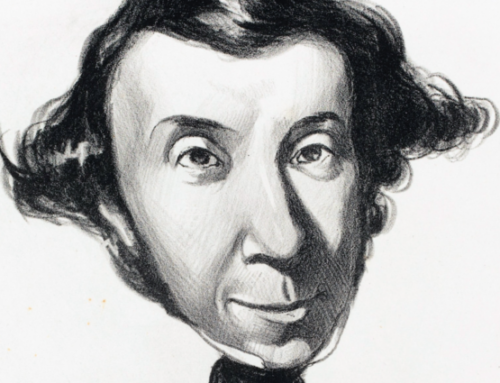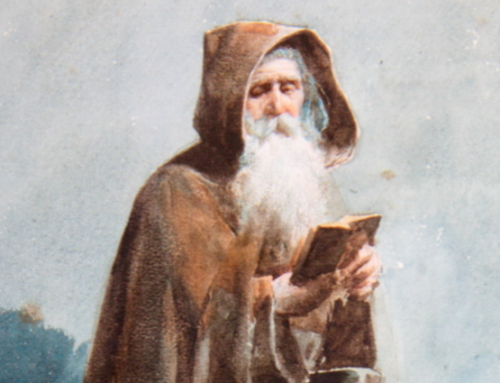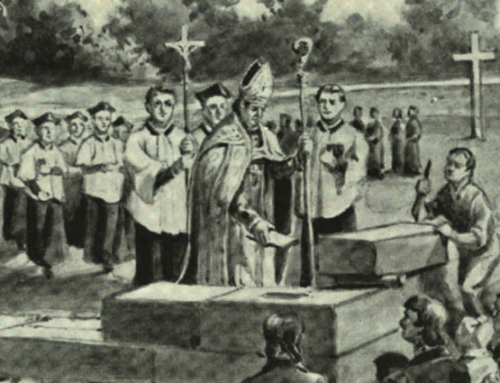American mythologist Joseph Campbell’s discernment of the hero’s quest and his distillation of world myth into an easily-digestible template has had a powerful impact on contemporary culture, including influencing George Lucas’ “Star Wars” films.
 The mythologist Joseph Campbell was the grandson of an Irish peasant-immigrant. Brought up in a Catholic home in New York, he embarked on an adventuresome life that echoed that of his contemporary Ernest Hemingway.
The mythologist Joseph Campbell was the grandson of an Irish peasant-immigrant. Brought up in a Catholic home in New York, he embarked on an adventuresome life that echoed that of his contemporary Ernest Hemingway.
With a deep interest in literature, he took a degree in English, then dropped out of academia to follow a path of intense, independent study, travel, and dabbling in writing fiction. A friend and collaborator of John Steinbeck—like Eliot, Pound, Hemingway and Gertrude Stein—Campbell was of that peculiar generation of American writers who combined wanderlust with erudition, producing literature and art that was as adventuresome as were their lives.
Campbell eventually married a dancer and divided his time between a small apartment in New York City and one in Hawaii. For nearly forty years, he taught comparative religion at Sarah Lawrence College and continued his studies in the interface among world religious traditions, the psychological theories of Freud and Jung, and the myths of various cultures. His lifetime’s greatest achievement is the 1949 volume The Hero With a Thousand Faces, in which he traces what he called the “monomyth” (a term he borrowed from James Joyce) through a multitude of incarnations in folklore, fairy tales, myths, and legends from cultures down through history and around the world.
The monomyth is the hero’s quest—the “one story to rule them all”—a pattern that lies below the story itself and unites the individual story with a pattern that connects with a universal pool of human consciousness. The core element of the monomyth is summed up by Campbell thusly: “The hero ventures forth from a world of common day into a region of supernatural wonder: fabulous forces are there encountered, and a decisive victory is won. The hero comes back from this mysterious adventure with the power to bestow boons on his fellow man.”
Campbell not only traces the pattern of the hero’s quest through various myths and legends, but discerns it also in the Old Testament sagas and the stories of the apostles and saints of the New Testament and the Christian church. The hero’s quest is an intriguing and endlessly repeating pattern in human culture because it reflects the natural quest of the human spirit not only towards achievement in the physical world, but more importantly, achievement in the realm of personal growth and spiritual fulfillment. The hero’s outward quest reflects his “character arc” or inner spiritual transformation. The quest makes the hero as much as the hero makes the quest.
Campbell’s discernment of the hero’s quest and his distillation of world myth into an easily-digestible template has had a powerful impact on contemporary culture. While his scholarship has been criticized by specialists and his theories disputed by academics, the impact of his work remains enormous.
George Lucas, the creator of the Star Wars films, credits Campbell with their success. Early in his career Lucas began studying Campbell’s work in order to understand the classic structure of stories. As he was revising the script for Star Wars, Lucas consciously began to weave the mythological structure into his interstellar fairy tale. He thus created a “myth for the American people” in a similar way that J.R.R. Tolkien created a “myth for the English people” with his Lord of the Rings trilogy.
The massive global popularity of both Tolkien’s and Lucas’ mythologies vindicates Campbell’s theory, and his thought has further fascinating ramifications. From his study of world myth and religions, Campbell proposed that the whole human race might be seen as engaged in the effort of making the world “transparent to transcendence.” In other words, as a human race, what matters most to us is the search for the eternal source of life and love. Religion is the method of that search, and myth is the way the map for the journey is communicated. The hero shows the way, if you like, so that we can learn how to embark on our own journey to the transcendent.
There is another level to myth, however, and that has to do with the theory of dramatic transference. As the reader or the audience in the cinema or theater participate with the story, they not only view the hero’s adventure as a spectator (and thus learn from his example), but they also empathize with the hero, and through an emotional transaction bind themselves to the hero—going through the adventure vicariously. As the hero gasps in horror, we gasp in horror. As he falls in love and weeps at his loss, we also shed a tear. Most importantly, when he faces a moral dilemma, we face the same difficult decision, and when he acts morally to defeat evil, we not only cheer for him—through this catharsis we make the same resolve in our own lives.
George Lucas was not the only cinematic storyteller to have been influenced by Campbell. Lucas’ friend Steven Spielberg has also admitted to Campbell’s influence and the story structure specialist for Disney studios—Christopher Vogler—has written The Writer’s Journey, a virtual handbook for screen writers and novelists on how to integrate Campbell’s insights in order to make a good story great.
Campbell’s life ended at his home in Honolulu in 1987 at the age of 83. Although he was brought up as a Catholic, he had wandered from his Catholic faith partially because of the way the Catholic religion had changed. He understood that the Catholic faith was the one religion in the modern world that had retained the sacramental vision and depth of ceremony that made “the transcendent transparent,” but after the Second Vatican Council, he believed, the Church herself threw out all that “ritualistic ceremonial stuff” and turned the Catholic religion into a peace-and-justice campaign—a happy meal served up in a building that looked like the waiting room of a dentist office. He is not the only one to have left the church dismayed by the modern stripping of the altars.
I was pleased therefore to have had a story related to me by a Catholic deacon in New England, where I had been invited to lead a retreat on preaching. I used Campbell’s hero’s quest to explore the structure of narrative preaching.
Over lunch the deacon explained that he had studied at the University of Chicago under Campbell’s friend, the anthropologist Mircea Eliade. The deacon informed me that on his deathbed Joseph Campbell asked for a Catholic priest and was reconciled with the church of his childhood.
Join Father Longenecker and Professor David Deavel on a pilgrimage tour to England in June. Go here to learn more.
The Imaginative Conservative applies the principle of appreciation to the discussion of culture and politics—we approach dialogue with magnanimity rather than with mere civility. Will you help us remain a refreshing oasis in the increasingly contentious arena of modern discourse? Please consider donating now.
The featured image (detail) is a photograph of Joseph Campbell at Feathered Pipe Ranch, Montana, late 1970s. This file is licensed under the Creative Commons Attribution 2.0 Generic license, courtesy of Wikimedia Commons.







I should admit I had my Joseph Campbell phase in my life. I’m also glad I moved beyond psychological insights to real faith, and to thee faith. Perhaps it’s time for me to look back on The Hero with a Thousand Faces and see how it stacks up today and how I’ve changed. It is reassuring to know that Campbell asked for a priest on his deathbed. May he be reconciled and have eternal rest in peace.
There is a tendency among those of no faith to treat writers like Campbell as semi-religious gurus. But reading his work through the lens of a solid Catholic faith can be quite enlightening and interesting.
Thank you Father. That really gives me an incentive now to relook at his work from my faith.
While I would not gainsay the man’s faith or return to same, I would say that, despite the “impact,” there is still quite the un-packing to do
“While his scholarship has been criticized by specialists and his theories disputed by academics…” I think this an understatement.
To tell the truth, it is truly wonderful that you enlightened people about the personality of Joseph Campbell because he is a really interesting and outstanding American mythologist whose activity affected a lot of people. I can say that Joseph Campbell was a really versatile person and he was truly unique in his field. I really like his theory because it carries such a deep sense and not a typical concept. I think that Campbell’s monomyth helps us think outside the box and expand the boundaries of our consciousness. It is not so surprising that his theories disputed by academics and that his scholarship has been criticized by specialists because it goes beyond the usual, but remains absolutely incredible. I really like his theory regarding our connection with the hero because it reveals a verity. We pass everything through ourselves in an emotional way when we observe the character and his adventure. Of course, we have a delicate connection with the hero, putting ourselves in his shoes and, for me, it is really incredible.
Thanks for this piece. I did a profile of Joseph Campbell and noted the conversion story mentioned here. I’m wondering if it can be traced to Father Kieran Murray, the priest chaplain who ministered to Campbell as he was dying.
Thank you for this.
I must admit, I find It is a bit puzzling that Tolkien and Campbell are mentioned as if they had the same approach or belief when it came to myths and myth-making.
The Limitation of Myth-Making for the Campbel
For Joseph Campbell myths do not refer to any objective reality or truth. Campbell is searching the caverns of our psyche for clues to understand life, free from religious claims, philosophical analysis, or objective truth. He is not leading you to something he claims is true. He is leading you to follow your own bliss, your own happiness, your own experience, and to find your own subjective sense of meaning. Myth is the vehicle, but not the point. Joseph put it this way in the TV show, The Power of Myth.
“God is an idea, but its reference is to something that transcends all thinking. Every god, every mythology, every religion, is true in this sense: it is true as metaphorical of the human and cosmic mystery.”
J.R.R. Tolkien, on the other hand, believed not only in objective reality and stories that point to true events and people, but he also believed in the ability of stories to expose us to truths about what is good, what is evil, and what is true about God. One of the key concepts of Tolkien is that of human “sub-creational powers.” In his draft letter to Peter Hastings, Tolkien writes the remarkable statement that,
“the whole matter [of my myth] from beginning to end is mainly concerned with the relation of Creation to making and sub-creation” (Letters 188, ).
Tolkien used myth to point to the Truth of the Gospel, while Campbell did not believe in any truth with a capital ‘T’, but taught people to follow their own bliss, and celebrate their own experience(which is all Joseph Campbell said religion is). For Campbell is there is no real Christ, Mother Mary or a true church. They are mere masks to embrace as we find them useful for our own myth.
We don’t know…but, that being the case, isn’t quite possible that Joseph asked for his final rites because he loved the experience and merely sought to experience the ritual, rather than it having any connection to an orthodox faith (which he scorned his whole life while following men like Teilhard de Jardin whom Pope Pius XII condemned)